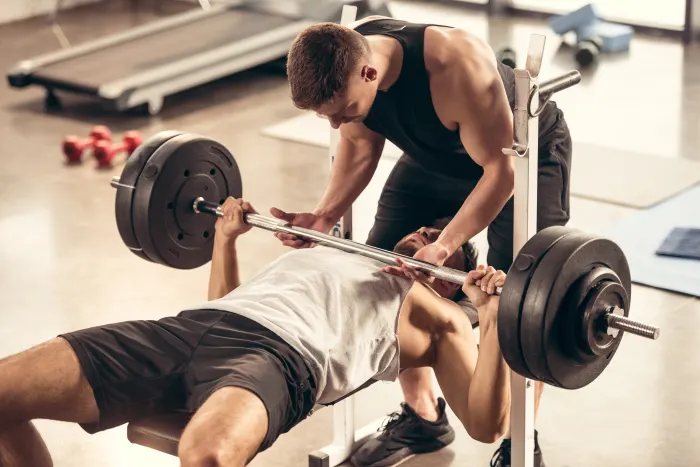Boost Your Chest Size by Training Your Bench Press One-Rep Max
When it comes to building a bigger, stronger chest, the bench press has long been regarded as one of the most effective exercises. But if you’ve been relying solely on high-rep sets or the same routine for years, it might be time to shift your focus. By training your bench press one-rep max (1RM), you can stimulate greater chest growth, enhance overall strength, and break through plateaus. Here’s how incorporating 1RM training into your routine can help you build massive chest muscles.
Why Train Your Bench Press One-Rep Max?
Your one-rep max is the maximum amount of weight you can lift for a single repetition. Training at or near your 1RM helps improve strength, power, and muscle hypertrophy. While hypertrophy (muscle growth) is typically associated with moderate rep ranges (6-12), maximal strength training—such as focusing on your 1RM—stimulates the muscles in a different way, leading to greater growth and more strength overall.
When you challenge your muscles to lift heavier loads, it recruits a greater number of muscle fibers, particularly the larger, more powerful fibers responsible for maximal strength and growth. This type of training is essential for breaking through plateaus and unlocking your chest’s full growth potential.
How to Safely Train Your Bench Press One-Rep Max
Before diving into 1RM training, it’s important to build a solid foundation of strength. Make sure you have a solid base of bench press volume (moderate weights and reps) and proper technique before attempting maximal efforts.
Here are some tips for safely training and testing your one-rep max:
- Warm Up Properly
A thorough warm-up is essential for avoiding injury and performing at your best. Start with lighter weights, gradually increasing the load. Perform at least 3-4 sets of progressively heavier bench presses, allowing adequate rest between sets. - Use Spotters and Safety Bars
Always train with a spotter, especially when attempting a 1RM. If you don’t have a spotter, consider using safety bars in a squat rack to catch the barbell if you fail the lift. - Periodize Your Training
Maximal strength training should be programmed strategically to avoid overtraining. Plan 1RM testing in cycles, typically after building strength over several weeks with sub-maximal loads. For example, after several weeks of moderate-to-heavy training, spend a few weeks focusing on heavy singles at 85-95% of your 1RM, before attempting a true max lift. - Rest Between Sets
Maximal strength training requires full recovery between sets. Aim for 3-5 minutes of rest after each attempt to ensure your muscles are fully recovered for your next heavy set. - Gradual Progression
Don’t rush the process. Gradually work your way up to attempting heavier lifts. Jumping too quickly to a new 1RM can cause injury. Focus on incremental progress over time to build long-term strength and muscle.
Benefits of Training Your 1RM for Chest Growth
- Increased Strength
The primary benefit of 1RM training is building pure strength. The stronger you get, the more weight you can lift in your chest exercises. This increased strength will also carry over into other lifts, such as the incline press or dumbbell presses, promoting overall chest development. - Muscle Fiber Recruitment
Training at 1RM loads activates both slow-twitch and fast-twitch muscle fibers, which are responsible for strength and size. The recruitment of these fibers encourages growth and strength development across all areas of the chest, from the upper and middle portions to the lower chest. - Mental Toughness
Attempting maximal lifts tests your mental resilience. It forces you to push through physical and psychological barriers, boosting confidence and mindset when approaching not only your bench press but all of your strength training efforts. - Breaking Plateaus
If your chest growth has stalled, adding 1RM training to your routine can help shock your body into making new gains. By pushing your body to lift heavier weights, you’ll force your muscles to adapt and grow stronger, resulting in increased muscle size.
Sample Bench Press One-Rep Max Training Cycle
Here’s a sample 6-week program to improve your bench press 1RM and promote chest growth:
Weeks 1-3: Strength Foundation Phase
- Focus on 4-6 reps per set at 70-80% of your current 1RM
- Perform 3-4 sets per exercise (flat bench, incline bench, dumbbell press)
- Include accessory exercises for shoulders, triceps, and chest (tricep dips, chest flyes, etc.)
Weeks 4-5: Intensification Phase
- Focus on 3-5 reps per set at 85-90% of your 1RM
- Include additional sets of singles (one rep) with 90-95% of your 1RM after your main lifts
- Add in accessory exercises for triceps, shoulders, and core
Week 6: Test Week
- Start by warming up with lighter sets and progress to heavier weights
- Work up to your max single repetition attempt
- After testing your 1RM, follow up with accessory exercises to promote recovery and muscle endurance
Final Thoughts
Training your bench press 1RM isn’t just about testing your limits—it’s a powerful way to increase chest size and strength over time. By incorporating 1RM training into your program, you not only improve your bench press performance but also stimulate muscle growth, improve your overall strength, and break through any plateaus you may have hit.
Just remember, safety first. Always use spotters and safety equipment when attempting maximal lifts. With consistency and dedication, you’ll see impressive gains in both strength and size that will take your chest development to the next level.
